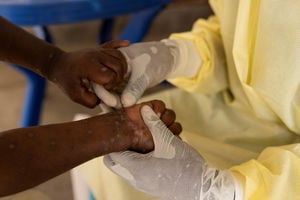Training lens on Mpox: The viruses are at it again

Symptoms of mpox include fever, aches and skin lesions.
What you need to know:
- The disease presents with the common symptoms we know of; fever, headache, muscle aches, back pain, lethargy and swollen lymph nodes.
- Then there is the pox-like rash that tends to happen most commonly on the hands, lasting two to four weeks.
Early this week, the Ministry of Health confirmed the diagnosis of Mpox in a man travelling from Uganda to Rwanda. Let us not even try to imagine what his route map looked like, as he was at the Taita Taveta border point between Kenya and Tanzania, at the time he was supposedly found.
Officially, we have joined the growing list of countries in Africa that have reported the notifiable disease, first identified in 1958, following two outbreaks of a pox-like disease occurring in colonies of monkeys kept for research. Despite being named “monkeypox” originally, the source of the disease remains unknown.
Despite not being informed of the location of the premises of these monkeys and their origin, the clever scientists apportioned suspicion on African rodents and non-human primates such as monkeys; as the potential reservoirs for the virus, from which it is able to infect people in an animal-to-human transmission.
The Africans did not exonerate themselves much when 12 years later, in 1970, the first human diagnosis was made, in the Democratic Republic of Congo! It made a home in Central and West Africa afterwards. This disease, a close relative of small pox, but a much less destructive relative nevertheless, made it to the WHO list of outbreaks in 2022, when it managed to make its way beyond the African borders and travel the world.
The good thing is, once the well-resourced countries feel threatened, we begin to see action, including innovations to tame the scourge. The monkeys’ feelings were also spared when WHO renamed the resultants disease Mpox in a bid for social correctness. However, the virus gets to retain its initial given name, Monkeyvirus.
The Monkeyvirus is scientifically described as a double-stranded DNA virus that belongs to the Orthopoxvirus genus of the Poxviridae family. It is a first cousin to small pox and presents in a similar fashion when it successfully causes Mpox disease.
According to the CDC website information page, Mpox has two subtypes; the Clade I subtype that is more aggressive, causing the more severe illness and deaths. It is mostly found in Central Africa and has a mortality rate of almost 10 per cent. Clade II is more common in West Africa and was the one responsible for the 2022 outbreaks. It is mild, with a mortality of less than one per cent.
No one is safe from Mpox disease, with the elderly, the immunosuppressed, the young children especially those below 12 months of age, pregnant women, and those with severe eczema being the most vulnerable to severe disease and death. Pets are not spared. It is, after all, a zoonotic disease that can move from animal to man and vice versa.
Even worse is how easy it is to spread from one person to the other; through literally every route: close contact including hugging, touching skin to skin, handshakes, and kisses; through sexual contact; contact with infected clothing, towels, personal items and bedding; and even through contact with surfaces where an infected person has touched. Essentially, it means that if someone close to you has Mpox disease, you are likely already quietly incubating yours.
The disease presents with the common symptoms we know of; fever, headache, muscle aches, back pain, lethargy and swollen lymph nodes. Then there is the pox-like rash that tends to happen most commonly on the hands, lasting two to four weeks! Severe disease is manifested by severe rashes that may be super-infected by bacteria; presence of the lesions in the mouth, throat, anus, rectum, vagina, urethra and the eyes; and even involvement of the lungs. Sadly, you remain infectious until the rashes completely heal.
So, what is the good news? Well, it has been shown that the infection is quite mild for a majority of patients, requiring only supportive care with hydration and analgesics for pain. For the hig- risk patient at risk of severe disease, there are Mpox vaccines that are currently approved for prevention of the disease. They greatly reduce the risk of infection in the event of exposure. However, these are not recommended for general population vaccination. They are reserved to be given on recommendation once a person’s risk has been evaluated. The vaccine is given as two doses, administered four weeks apart. Full immunity by the recipient is achieved two weeks after receiving the second dose.
Further, there is an antiviral drug that was developed to treat smallpox, known as tecovirimat, which was approved in January 2022 by the European Medicines Agency, for the treatment of Mpox under exceptional circumstances. It still remains for use in very special circumstances, hence not widely available.
It is going to be whole more difficult to reign in on the spread of Mpox should it take root locally. The universal public health measures fully apply; avoiding close contact, handwashing with soap and water, use of medical-grade face masks, cleaning of surfaces, utensils and contaminated clothes, bedding and personal use items. Avoid sexual contact with those who are sick, and further, use of condoms is recommended for at least 12 weeks after full recovery.
For those who are infected, isolation is essential to minimise transmission of disease to others around us. One is infectious until the lesions have crusted over, the scabs have fallen off and a new layer of skin has formed underneath. Where ultimate isolation is not possible, the contacts should employ all possible measures to minimise exposure.
With this being a zoonotic disease, wild animals and even pets may carry the monkeypox virus. If you are infected, avoid contact with your pets as there is a possibility of infecting them. It is critical to avoid unprotected contact with wild animals, during hunting, skinning, and handling of potential reservoir animals that are sick or dead from unknown causes.
We may be up against a new challenge. This is an opportunity to demonstrate the lessons we learnt from the Covid-19 pandemic. Let us minimise panic, apply public health measures in a friendly manner where the population is sufficiently involved, educated, supported and given all due respect with regard to their autonomy!
Dr Bosire is an obstetrician/ gynaecologist





